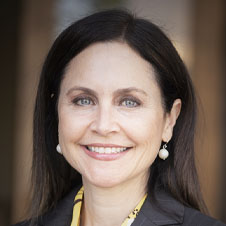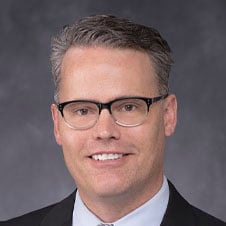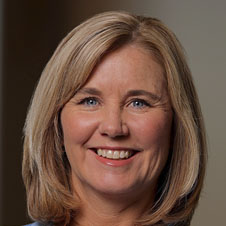Tiffany Pankow, MD, chief of caregiver wellness and patient experience at HonorHealth, recognized the need for a more robust tool to understand and help benchmark where the Arizona health system stood on physician well-being. She and her colleagues looked to the AMA for help to measure the work HonorHealth has already been doing and set the stage for where to turn their focus next.
HonorHealth chose the AMA Organizational Biopsy® “to measure what we’ve been asking more qualitatively all along,” said Melanie Patton, MD, one of the health system’s associate chief medical officers. HonorHealth is a nonprofit health system with six hospitals, and more than 100 primary and specialty care locations with roughly 800 employed physicians, serving more than three million patients a year across the Scottsdale and Phoenix areas.
Working with the AMA “was a way to formalize and measure the work we’ve already been doing, see how that compares nationally and use that information to create action plans moving forward,” Dr. Patton added.
The AMA Organizational Biopsy uncovered that 77.6% of HonorHealth physicians reported feeling satisfied with their job compared with the national benchmark of 69%. On top of that, 46.9% of their physicians reported job-related stress, compared with 54.2% nationwide.
Meanwhile, just 41.6% of physicians at HonorHealth reported feeling some level of burnout, far below the 53% benchmark rate across the nation. And 36.5% reported plans to leave the organization within two years.
Other survey instruments are not “as extensive as what the AMA survey tool offered us,” said John Neil, MD, executive vice president and chief physician executive and network strategy officer at HonorHealth. “We, like everybody else, are thinking a lot about our caregiver community right now, so it’s been helpful. And it really has reinforced the things we thought we knew.”
Dr. Pankow added that “it's been great working with the AMA. They've been very supportive in helping us create the survey and really nail down the key areas to get engagement from our physicians,” she said. The AMA “also really helped with ideas of how to promote it and execute it with our team.”
“The fact that the AMA is invested in well-being and pushing health systems to focus on this is extraordinarily important,” Dr. Neil said. “We have a long way to go. It’s not like we’ve got to figure it out now, but at least we’re committed, and it starts there.
“I hope through AMA leadership, people understand the importance and are willing to commit and invest time and resources. Because without it, I’m not sure where the health systems are going to be in five or 10 years,” he said.
Here is what HonorHealth was able to accomplish through its use of the AMA Organizational Biopsy.
Set a baseline for burnout
“I was pleased to see that our burnout level is lower than the national average, but that’s not our end goal. We still have work to do,” said Dr. Pankow.
Dr. Patton said, “HonorHealth is committed to avoiding complacency.” On physician burnout, “it’s never something you achieve 100% and then move on,” she said. “There’s always room for improvement, but it was nice to celebrate the steps we have taken and that we’re headed in the right direction.”
The results of the AMA Organizational Biopsy are “reassuring and reinforcing the emphasis that we put on this, that we are making progress,” said Dr. Neil, “but it’s also a little depressing because we know that there’s still a lot of angst, stress and discontent. And, for me, that was a real take home.”
Take the leap to gain recognition
In 2023, HonorHealth applied for the AMA Joy in Medicine™ Health System Recognition Program for the first time. They received silver-level recognition, which is not common for first-time applicants.
The recognition “was really uplifting for the organization,” Dr. Neil said. “It makes us feel like we’re on the right track and that what we’re doing matters.
“It energizes the people who are invested in this work to get this silver-level recognition and feel validated in what we’re doing,” he said. “But nobody wants to be on the silver medal podium at the Olympics. You want to be on the gold medal one, so it also motivates us to try to do whatever we need to do to go for gold. And if there’s a platinum, we’ll do that too.”
Standardize EHR workflows
For time on the EHR outside of normal hours, 19.5% said they were spending more than eight hours compared to 16.6% at the national level. Meanwhile, 27.8% noted spending two hours or less on the EHR outside normal practice hours compared to 32.2% at the national level.
“There’s been a lot of standardization of different workflows, and we’re pretty fast at adapting some of the new workflows within Epic,” Dr. Pankow said, also noting that “we just recently started a clinician technology experience council, and this is really around how we can better engage our clinicians to get their ideas at the front line to start making improvements.
“We also started the getting rid of stupid stuff initiatives that the AMA talks about across our operations, including Epic and EMR, for other ways that we can streamline the work we do,” she added. “This also involves training more superusers so there’s more at-the-elbow support ... to see how we can streamline it.”
Additionally, there’s been a lot of work “creating standardized smart phrases within Epic that physicians can use but also around our inbox portal messages, which we know is a big challenge for a lot of us,” she said, noting “it provides standardized processes for addressing portal messages so that the physicians don’t have to touch all of them.
“And then, we’re standardizing the questions and what information we’re getting so that hopefully by the time it gets back to the physician, they have more of the information they need to execute,” Dr. Pankow added. “It eliminates the back and forth between a medical assistant and a physician to get additional information.”
Dr. Pankow and her colleagues are most excited about trying to improve “efficiency of practice and help move the needle on it this year,” she said, noting “one of my goals is really to get some of those additional processes in place to improve that work outside of work where we can.”
Connect all physicians and team members
“We have a secure texting system called Tiger-Text and it allows physicians to collaborate securely across the community to both our employed HonorHealth physicians and affiliated physicians,” Dr. Pankow said. “It’s a great way to stay connected and one of those efficiencies of practice that really helps our doctors.”
Dr. Patton said the effort “creates a connection for physicians” and other team members. “It has brought people together and instead of potential barriers when going through the front office, physicians can immediately reach out to a colleague.
“You can have that connection and it feels a bit more like med school or residency, where you can directly connect with the right person,” she added. This ease of communication “creates a different sense of belonging” that so many health care organizations strive to achieve.”
In fact, HonorHealth’s survey results showed that 96.3% of respondents felt that there was respectful communication between physicians and nonphysician providers and practice managers or other leaders. Among physicians and the care team, 92.5% agreed. Meanwhile, among physicians and their consulting colleagues, 98.7% felt respectful communication existed.
Tie together well-being, patient experience
Instead of the chief wellness officer role that has become increasingly prevalent, Dr. Pankow has taken on a title that connects patient experience and the well-being of physicians and other health professionals.
“We really wanted to overtly tie together the idea that caregiver well-being equates to patient experience and vice versa. Those two things are symbolic and can build on themselves,” Dr. Neil said. “We thought creating a role that by its name included both was important. We also wanted to put a scope under that and connect some dots.
“And the dots were the patient experience work that was historically in one silo. The caregiver wellness work was in a different one,” he added. “Then we have our employee health department, which was in another silo, completely disconnected from caregiver wellness—which didn’t make a lot of sense. So, we wanted to connect them.”
Another priority is the basic safety of physicians and other team members.
“One of the real tragedies of health care in 2024 is that our caregivers can’t show up to work and feel safe,” Dr. Neil said. “They’re getting either verbally or—in some cases—physically assaulted by people who seem to think it’s OK to do so.”
That is why “we thought positioning all of those things under a single leader would allow them to start connecting the dots in a more meaningful way and get the synergies that we needed,” he said.
Figure out next focus areas
Physician leaders at HonorHealth also discussed their successful efforts to streamline primary care scheduling and enable doctors and other health professionals to live more healthfully and find more purpose in their work. But one shortcoming these executives identified was a lack of a reliable instrument to measure their own effectiveness as leaders.
Dr. Patton said they have focused on elements such as communication, engagement and feedback, but added that “we haven’t really had a great way of measuring it.”
The aim is to find better ways to measure physician leadership efficacy “when creating action plans to make sure that is transparent and known,” she said. This includes “focusing even more on our leaders—everything from coaching and opportunities of developing, creating more opportunity for more leaders.”






